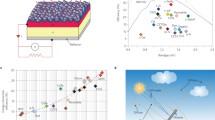Abstract
The primary targets of our project are to drastically improve the photovoltaic conversion efficiency and to develop new energy storage and delivery technologies. Our approach to obtain an efficiency over 40% starts from the improvement of III–V multi-junction solar cells by introducing a novel material for each cell realizing an ideal combination of bandgaps and lattice-matching. Further improvement incorporates quantum structures such as stacked quantum wells and quantum dots, which allow higher degree of freedom in the design of the bandgap and the lattice strain. Highly controlled arrangement of either quantum dots or quantum wells permits the coupling of the wavefunctions, and thus forms intermediate bands in the bandgap of a host material, which allows multiple photon absorption theoretically leading to a conversion efficiency exceeding 50%. In addition to such improvements, microfabrication technology for the integrated high-efficiency cells and the development of novel material systems that realizes high efficiency and low cost at the same time are investigated.







Similar content being viewed by others
References
Oshima, R., A. Takata, Y. Shoji, K. Akahane, and Y. Okada. 2010. InAs/GaNAs strain-compensated quantum dots stacked up to 50 layers for use in high-efficiency solar cell. Physica E 42: 2757–2760.
Sugiyama, M., K. Sugita, Y. Wang, and Y. Nakano. 2011. In situ curvature monitoring for metalorganic vapor phase epitaxy of strain-balanced stacks of InGaAs/GaAsP multiple quantum wells. Journal of Crystal Growth 315: 1–4.
Wang, Y., Y. Wen, K. Watanabe, M. Sugiyama, and Y. Nakano. 2010. InGaAs/GaAsP strain-compensated superlattice solar cell for enhanced spectral response. In Proceedings 35th IEEE photovoltaic specialists conference, 3383–3385.
Wang, Y.P., S. Ma, M. Sugiyama, and Y. Nakano. 2012. Management of highly-strained heterointerface in InGaAs/GaAsP strain-balanced superlattice for photovoltaic application. Journal of Crystal Growth. doi:10.1016/j.jcrysgro.2011.12.049.
Author information
Authors and Affiliations
Corresponding author
Rights and permissions
About this article
Cite this article
Nakano, Y. Ultra-High Efficiency Photovoltaic Cells for Large Scale Solar Power Generation. AMBIO 41 (Suppl 2), 125–131 (2012). https://doi.org/10.1007/s13280-012-0267-4
Published:
Issue Date:
DOI: https://doi.org/10.1007/s13280-012-0267-4




